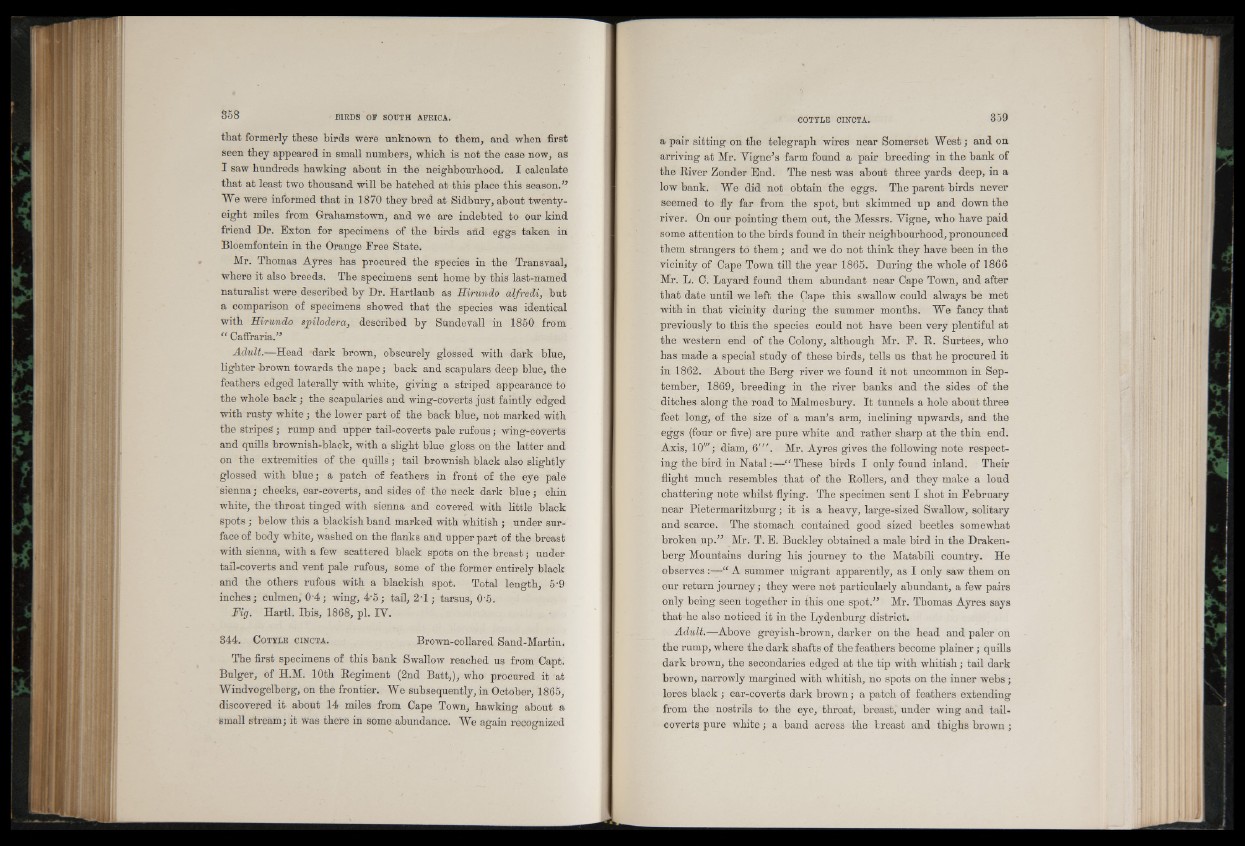
that formerly these birds were unknown to them, and when first
seen they appeared in small numbers, which is not the case now, as
I saw hundreds hawking about in the neighbourhood. I calculate
that at least two thousand will be hatched at this place this season.”
We were informed that in 1870 they bred at Sidbury, about twenty-
eight miles from Grahamstown, and we are indebted to our kind
friend Dr. Exton for specimens of the birds and eggs taken in
Bloemfontein in the Orange Free State.
Mr. Thomas Ayres has procured the species in the Transvaal,
where it also breeds. The specimens sent home by this last-named
naturalist were described by Dr. Hartlaub as Hirundo alfredi, but
a comparison of specimens showed that the species was identical
with Hirundo spilodera, described by Sundevall in 1850 from
“ Caffraria.”
Adult.—Head dark brown, obscurely glossed with dark blue,
lighter brown towards the nape; back and scapulars deep blue, the
feathers edged laterally with white, giving a striped appearance to
the whole back; the scapularies and wing-coverts just faintly edged
with rusty white; the lower part of the back blue, not marked with
the stripes; rump and upper tail-coverts pale rufous; wing-Coverts
and quills brownish-black, with a slight blue gloss on the latter and
on the extremities of the quills; tail brownish black also slightly
glossed with blue; a patch of feathers in front of the eye pale
sienna; cheeks, ear-coverts, and sides of the neck dark blue; chin
white, the throat tinged with sienna and covered with little black
Spots ; below this a blackish band marked with whitish ; under surface
of body white, washed on the flanks and upper part of the breast
with sienna, with a few scattered black spots on the breast; under
tail-coverts and vent pale rufous, some of the former entirely black
and the others rufous with a blackish spot. Total length, 5-9
inches; culmen, 0 4 ; wing, 4-5; tail, 2T ; tarsus, 05.
Fig. Hartl. Ibis, 1868, pi. IY.
344. C o ttl e cincta. Brown-collared Sand-Martin.
The first specimens of this bank Swallow reached us from Capt.
Bulger, of H.M. 10th Regiment (2nd Batt,), who procured it at
Windvogelberg, on the frontier. We subsequently, in October, 1865,
discovered it about 14 miles from Cape Town, hawking about a
small stream; it Was there in some abundance. We again recognized
a pair sitting on the telegraph wires near Somerset West; and on
arriving at Mr. Vigne’s farm found a pair breeding in the bank of
the River Zonder End. The nest was about three yards deep, in a
low bank. We did not obtain the eggs. The parent birds never
seemed to fly far from the spot, but skimmed up and down the
river. On our pointing them out, the Messrs. Yigne, who have paid
some attention to the birds found in their neighbourhood, pronounced
them strangers to them; and we do not think they have been in the
vicinity of Cape Town till the year 1865. During the whole of 1866
Mr. L. C. Layard found them abundant near Cape Town, and after
that date until we left the Cape this swallow could always be met
with in that vicinity during the summer months. We fancy that
previously to this the species could not have been very plentiful at
the western end of the Colony, although Mr. F. R. Surtees, who
has made a special study of these birds, tells us that he procured it
in 1862. About the Berg river we found it not uncommon in September,
1869, breeding in the river banks and the sides of the
ditches along the road to Malmesbury. It tunnels a hole about three
feet long, of the size of a man’s arm, inclining upwards, and the
eggs (four or five) are pure white and rather sharp at the thin end.
Axis, 10'"; diam, 6'" . Mr. Ayres gives the following note respecting
the bird in Natal:—“ These birds I only found inland. Their
flight much resembles that of the Rollers, and they make a loud
chattering note whilst flying. The specimen sent I shot in February
near Pietermaritzburg; it is a heavy, large-sized Swallow, solitary
and scarce. The stomach contained good sized beetles somewhat
broken up.” Mr. T. E. Buckley obtained a male bird in the Draken-
berg Mountains during his journey to the Matabili country. He
observes :—“ A summer migrant apparently, as I only saw them on
our return journey; they were not particularly abundant, a few pairs
only being seen together in this one spot.” Mr. Thomas Ayres says
that he also noticed it in the Lydenburg district.
Adult.—Above greyish-brown, darker on the head and paler on
the rump, where the dark shafts of the feathers become plainer; quills
dark brown, the secondaries edged at the tip with whitish; tail dark
brown, narrowly margined with whitish, no spots on the inner webs;
lores black ; ear-coverts dark brown; a patch of feathers extending
from the nostrils to the eye, throat, breast, under wing and tail-
coverts pure white; a band across the breast and thighs brown;